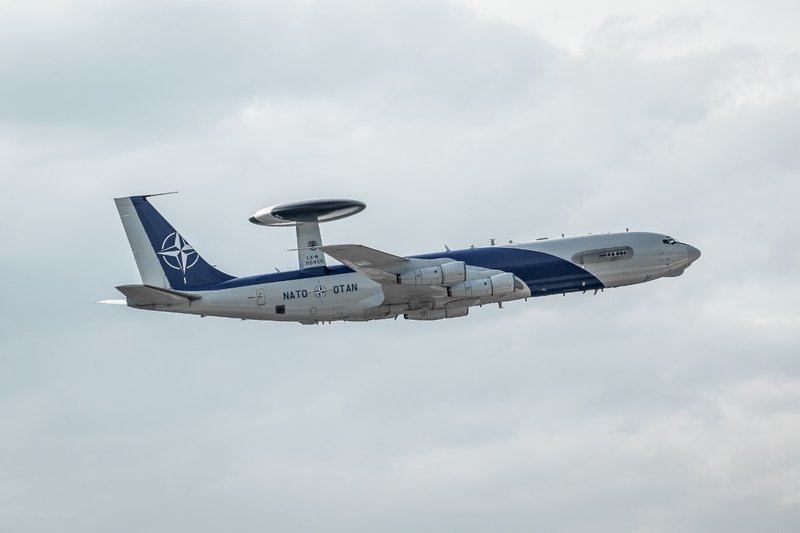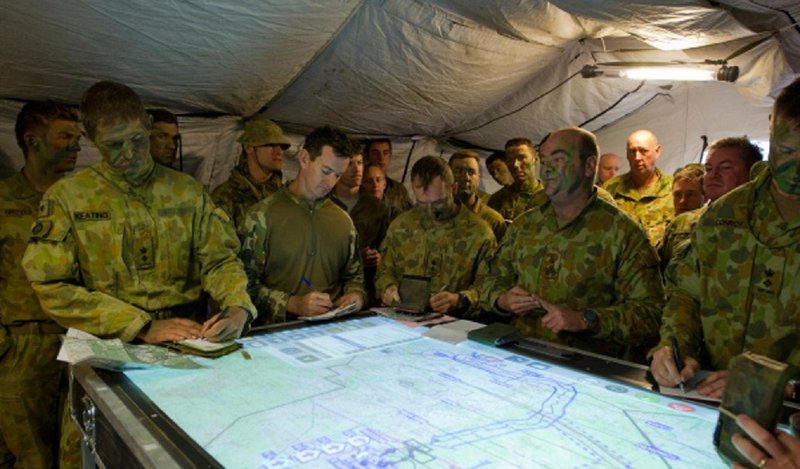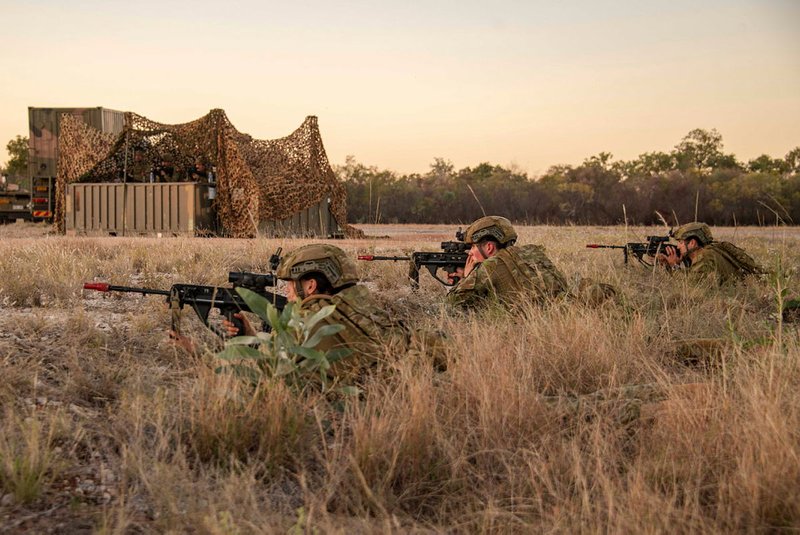Decisive Edge Newsletter | Digital Battlespace | August 2023
Newsletter Sponsor:
Changing of the guard for UK airborne early warning – new aircraft, new CONOPS
The Royal Air Force is developing fresh concepts of operations for its new Boeing Wedgetail airborne early warning and control aircraft.
The RAF received its first Boeing E-3D Sentry Airborne Warning and Control System (AWACS) jets from 1991, taking a total of seven aircraft.
Now retired, the Sentries are being replaced with three Boeing E-7A Wedgetail Airborne Early Warning and Control (AEWC) jets. The long- term aspiration is for the air force to eventually fly five of the aircraft, designated locally as Wedgetail AEW1, although only three are currently funded.

The Wedgetail is (as one would hope) a qualitative improvement on the Sentry. This is arguably most noticeable in the respective AEW radars equipping each aircraft.
The Sentry was outfitted with the Northrop Grumman AN/APY-1/2 S-band radar, while the Wedgetail sports the same company’s Multi-Role Electronically Scanned Array (MESA) system. This is an L-band radar and, unlike the AN/APY-1/2, does not rotate and is housed in a large ‘canoe’ fairing atop the E-7A’s fuselage.
A fixed array reduces the number of spare parts and complexity of design compared to the AN/APY-1/2. Importantly, the MESA uses an active electronically scanned array (AESA) and is not reliant on physical rotation through 360 degrees like its predecessor.
An AESA is much more responsive – radar beams are electronically steered, detecting targets and generating tracks in milliseconds. Moreover, AESA signals can rapidly change their characteristics, making the radar more resistant against electronic countermeasures.
This year’s Military Radar Conference, held in London in late June, gave delegates the chance to learn more about the concept of operations for this new RAF asset.
The MESA radar performs both air and surface search, allowing it to assist maritime operations. The aircraft’s Identification Friend or Foe (IFF) system is also integrated into the MESA’s arrays.
While compatible with legacy NATO protocols, the MESA IFF system only uses the military Mode-5, a militarised version of the international civilian Mode-S secondary surveillance radar protocol.
RAF representatives told delegates at the conference that the decision to not incorporate Mode-S was made on cost grounds. Mode-S information can be passively received by the aircraft via a standard Automatic Dependent Surveillance-Broadcast installation.
Similarly, the aircraft will have a receiver for signals sent by civilian vessels equipped with the Automatic Identification System (AIS). AIS is mandated by the International Maritime Organisation for all commercial shipping displacing over 300 gross tonnes, and all passenger vessels are obliged to have a transmitter. AIS information will help further enrich the recognised maritime picture produced by the MESA radar.
The UK aircraft will have Boeing’s SE-200C Electronic Support Measure, while communications systems include HF and VHF/UHF radios. These latter radios are compatible with the Second-Generation Anti-Jam Tactical UHF Radio for NATO (SATURN) waveform. SATURN is used extensively across the alliance, helping improve interoperability.
Alongside conventional communications, V/UHF SATCOM capabilities are fitted. While Link-16 is the only tactical data link (TDL) the aircraft will carry, in the future, the fleet may receive NATO’s forthcoming Link-22 TDL. Using frequencies of 2-29.9MHz and 225-399.975MHz, Link-22 supports maritime operations.

Above: One role for the RAF’s Wedgetails will be contributing to NATO’s wider AEW coverage alongside the alliance’s own E-3 fleet. No replacement for the latter has been selected yet. (Photo: NATO)
In part, the RAF Wedgetails will support NATO’s overall AEW mission currently provided by alliance-owned E-3As based at Geilenkirchen, western Germany. Link-16 will allow the RAF aircraft to share their radar and tactical data directly with NATO’s Air Command and Control System.
Specifically, data can flow to NATO’s Combined Air Operations Centre (CAOC) at Uedem, western Germany. This facility protects European airspace and air approaches north of the Alps. A second CAOC at Torrejón, south of Madrid, performs a similar mission for the alliance’s southern airspace. Along with assisting air defence, the Wedgetails will support overall air battle management.
Domestically, the new RAF aircraft will assist UK air defence, helping the management of interception of uncooperative aircraft threatening the country’s airspace.
RAF representatives also said the jets can assist UK civil authorities. For example, the Wedgetails could help coordinate large-scale air-sea rescue operations or help manage movements of aircraft responding to national contingencies such as natural disasters.
The Wedgetail clearly promises a major step forward in UK and NATO AEW&C acumen. The RAF is working closely with established E-7A operators, notably the Royal Australian Air Force and Turkish Air Force to develop Wedgetail tactics, techniques and procedures.
Despite the E-7A being a more capable aircraft than the Sentry, the RAF is receiving less than half the platforms in its original E-3 delivery. It is likely the service will continue to urge the purchase of an additional two jets, the demand for which is likely to be strong.
Traditionally, AEW&C aircraft are high-demand, low-availability assets. While the presentation at the Military Radar Conference outlined the aircraft’s mission fit and expected roles, RAF Wedgetails are likely to assume additional tasks in the future. Invariably, such versatile platforms are used for a myriad of purposes beyond their original specification.
How Ukraine’s coders have developed battle management tech for smartphones and tablets
The ongoing war in Ukraine has resulted in some impressive technological innovation in the command and control domain by the country’s defence industry.
The competences of Ukrainian coders have been noteworthy regarding battle management system (BMS) technology, as illustrated by the Kropyva system.

Above: This diagram clearly illustrates how the Kropyva battle management system can share information across the manoeuvre force at the tactical level. (Image: Logika)
Kropyva, which translates as ‘nettle’ in English, has been developed by Ukraine’s Logika Design Bureau based in Kyiv. Sources in the country’s defence establishment told Shephard that work on Kropyva began in 2014, the same year that Russia invaded and occupied Crimea and parts of the eastern Donbass region.
Developing Kropyva was not easy. The sources said that alongside technical questions, ‘probably overcoming bureaucracy issues were the most boring and challenging’.
Technical hurdles included facilitating mobile ad-hoc networking across low-bandwidth communications links. Likewise, providing the wherewithal to facilitate ballistic calculations for a multitude of artillery systems was similarly challenging.
Kropyva provides standard BMS services including cartographic information, blue and red force tracking, data exchange and mission planning, according to its manufacturer.
The company says that Kropyva is primarily used by Ukrainian land manoeuvre forces. The software can be easily loaded onto civilian standard devices including smartphones or tablets using the Android operating system.
Despite its primary applicability to land warfare, Ukrainian sources have said the system can be customised for the air and maritime domains. To this end, its digital mapping functions have already been used by Ukrainian forces beyond the land environment.
From a user perspective, the sources said Kropyva is employed at the tactical, typically battalion, level and below. Nonetheless, ‘brigade level staff also use it’. One useful element of Kropyva is that it can be upgraded across standard tactical communications networks.
Kropyva joins a host of other Ukrainian-developed BMS/C2 systems. For example, Correction D-30 software can be used on Android systems to assist artillery fire control, while Delta software provides a comprehensive tactical mapping and situational awareness system.
Meanwhile, MilChat enables secure messaging and ComBat Vision provides military intelligence services.

Above: Kropyva can be easily integrated onto devices running the Android operating system. (Photo: Logika)
In recent years, the Russian military has embarked on a wholesale digital overhaul of its forces, including the army. These modernisations resulted from the Russian government launching its so-called New Look defence reforms in 2010, driven by military performance during the 2008 Russo-Georgian War.
Digital modernisation in Russia has yielded systems like the Andromeda-D BMS, believed to be chiefly used by airborne forces.
Nonetheless, the roll-out of digital BMS/C2 systems across Russian land forces has been patchy, Shephard understands.
Questions remain as to the extent to which disparate Russian computerised BMS/C2 systems can interoperate. To be fair, this latter point is also relevant vis-à-vis Ukrainian forces.
However, interoperable digital C2 and BMS could give Ukrainian forces an important qualitative advantage on the battlefield. War has spurred the country’s digital defence innovation, a trend that shows little sign of abating.
What is Australia is getting for its billions spent on battlefield command and control?
The Australian Army is moving towards the final phase of its Land 200 Phase 3 Battlefield Command System initiative.
The army says that the Land 200 Phase 3 project will provides it with a new battle management system (BMS) and integrated tactical communications network.
On 13 July, the Australian government gave the programme first pass approval. This allows the Department of Defence to open a tender to find an integration partner for the initiative. According to Australia’s National Audit Office, this phase of the overall Land-200 programme could cost up to $1.3 billion.

Above: The Australian Army’s Land 200 Phase 3 initiative involves a wholesale modernisation of the force’s battle management systems and communications. (Photo: Australian DoD)
Phase 2 of Land 200 was approved in 2017 with media reports stating this covered delivery of training and simulation capabilities for the associated BMS. BMS for army platforms were covered in Tranche 2 along with brigade headquarters C2 software applications and interoperability provisions for allied partners.
Tranche 1 bundled together several programmes concentrating on vehicular radios and dismounted soldier BMS. This element also covered the sharing of C2 data between infantry and vehicle commanders.
A statement provided to Shephard by the Australian Department of Defence said that Land 200 Phase 3 will ‘provide the basis for the Land Common Operating Picture and will provide one of [the] army’s data interfaces into the [Australian armed forces’] Joint C2 architecture. This will allow deployed joint force headquarters and land forces to exchange important command and control information.’
The goal of this effort is to create overarching and mutual battlespace situational awareness, the statement added.
Delivery of Land 200 Phase 3 focuses on ‘the highest priority elements of the BMS-C2 capability both in fixed and deployable headquarters, and in command and control vehicles’. The logic is for this to provide a C2 link networking ‘operational integrated forces with the army tactical formations down to combat team level.’
For all intents and purposes, this deepens the networking between the operational and tactical levels across the army’s manoeuvre force. SitaWare already provides the BMS-C2 application. This phase of Land 200 builds on this ‘interim battle management system that has been in use within the army since 2020’.
The BMS-C2 application will share its data across deployable local area networks, will be used in tactical land headquarters and ‘implemented within the vehicle standard operating environment’.
Furthermore, BMS-C2 will be able to share data outwards using ‘in-service bearers, including a combination of previously delivered enhanced positioning location and reporting systems and radios for vehicles, and systems within the Battlefield Telecommunications Network headquarters’.

Above: Land 200 will facilitate better communication and data-sharing between infantry and command posts. (Photo: Australian DoD)
Although reports had stated that the completion of the overall Land 200 enterprise had suffered some delays because of the COVID-19 pandemic, the programme is now moving forward.
Given the tensions between the People’s Republic of China and the US and its allies in the Asia-Pacific region, Land 200 is an important modernisation of the army’s C2 and communications. This is likely to improve the punch of the army’s manoeuvre force while enhancing coalition networking and data-sharing.
Don't want to miss out on future Decisive Edge content? Make sure you are signed up to our email newsletters.











